Social media is an incredibly powerful tool. Changemakers across the globe rely on its power and reach to make the world a better place. People use it to be entertained and stay in touch with their family and friends.
The numbers don’t lie. More than 3.6 billion people were using social media worldwide. This number is expected to surge to almost 4.41 billion by 2025 as smartphone and internet penetration grows in emerging markets. Users spend 144 minutes checking social media per day on average.
It’s hard to imagine living in a world right now where social media does not exist. These networks have cemented their place in our lives in a very short period of time. It’s impressive that most of us can’t go a day without checking up on social media even though these networks have only been around for a decade or so.
They’ve also given businesses the opportunity to reach billions of potential customers across the globe. The sheer amount of data that these networks collect enables them to offer businesses with laser-like targeting options for their campaigns, enabling them to achieve a greater ROI that no other form of marketing can even come close to.
The fleeting nature of Social Media Trends
Social media trends can change very rapidly. It’s partly due to the networks themselves. They keep adding new features and changing algorithms to meet their own business objectives. Any such change could flip a brand’s entire social media marketing strategy on its head. Something that worked before isn’t necessarily going to work in the future.
Trends that emerge due to something going viral can fizzle out pretty quickly. Remember the Ice Bucket Challenge? People would get doused with ice cold water to raise awareness and donations for ALS charities.
They would also nominate other people in the video which is how the Ice Bucket Challenge went viral. Various iterations of the challenge had been floating online for years. It was only in 2014 that this trend went viral across the globe. Over $220 million was raised worldwide for ALS research.
In 2015, an attempt was made by several ALS organizations in the United States to re-introduce the challenge. It wasn’t successful because the trend had fizzled out by then and social media users simply didn’t respond in the way that they had in the previous year.
Businesses need to constantly adapt to changing trends in order to maximize the ROI from their social media marketing campaigns. A significant rethink of strategies is required in 2021 as the social media landscape has once again gone through a significant shift due to the COVID19 pandemic.
5 Social Media Trends you should be following in 2021
1. Live streams are in vogue
Video content really took off in 2020 as people were forced indoors by the pandemic. Suddenly, everything from work to school and even catching up with friends could only be done through video calls.
People also had more free time since they had to be indoors most of the time. This meant they consumed more video content. Artists turned to live streams for performances while singers performed impromptu virtual concerts for their fans online.
This shift in consumer behavior has carried over into 2021. A lot more people now prefer interacting with their favorite brands live without having to leave their home. Live streaming will continue to become more popular and businesses should certainly make it a part of their 2021 strategy.
2. Video content is king
One of the reasons why conventional blogs are finding it hard to thrive is that people simply prefer consuming video content now. YouTube is the world’s most popular resource for informational and entertainment content on just about everything under the sun.
However, YouTube is now extremely saturated. Look elsewhere if you’d like your video content to stand out. There are plenty of other social video channels that provide access to a wide audience. Tailor your video content for channels like IGTV, Instagram Reels, Twitter Fleets, etc.
Utilize all of these different social media channels to reach out to new audiences. You may also find that the engagement rates may be higher on these channels compared to YouTube since it’s much easier for viewers to share content that they like with other people.
3. Get on the social commerce train
Social media networks have transformed the way people purchase things online. For example, a customer might like a hat worn by their favorite influencer. They can click on the product tag in the influencer’s post and be instantly taken to that brand’s shop on Facebook. They can purchase the hat there and then without ever having to switch tabs.
Social media greatly influences purchase decisions. Capitalize on this trend by setting up your own social media storefronts. Complement your customers’ visual research journey with convenience and a swift checkout experience.
4. Create content that resonates with your customers
A lot of people have become more mindful about their place in the world post pandemic. They understand that we as a species need to change things in order to ensure the survival of our future generations. There’s more empathy and thoughtfulness in their actions. They’re now more likely to support businesses that share the same social values.
Now is the time to show a more relatable side of your business. Highlight the efforts that you make for environmental protection, for example, or the social responsibility projects you’ve initiated to help people in the community. Talk about the brand’s larger purpose or highlight customer stories to form a deeper connection with your audience.
5. Launch purpose-driven campaigns
74% of respondents in a Twitter survey said that they prefer brands to showcase an act of kindness. Brands that are seen to be supporting society during a crisis evoke a more positive perception among customers.
Purpose-driven social media campaigns are thus a great way for brands to elevate themselves. This can be achieved either through support for vulnerable members of the community or through support for a cause that people care deeply about.
Remember to always be authentic
Authenticity goes a long way online. All content and campaigns, particularly those related to issues or a crisis, must be genuine and authentic. Your audience shouldn’t feel that the brand is simply jumping on the bandwagon to increase its visibility. Such negative perception can be difficult to shake off once created.



